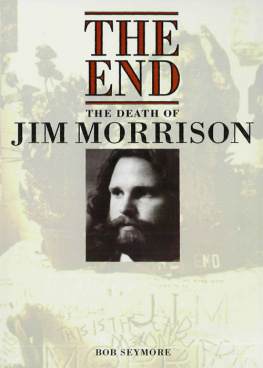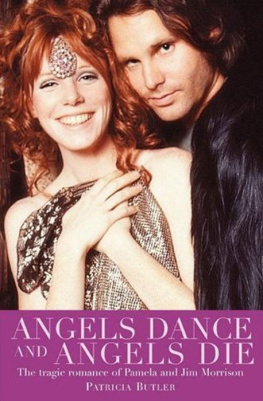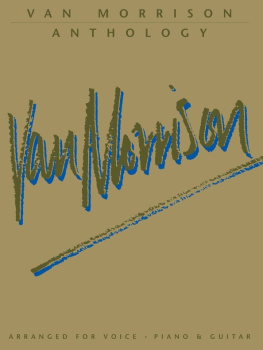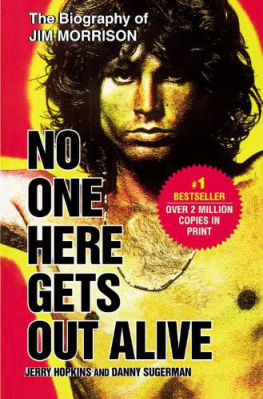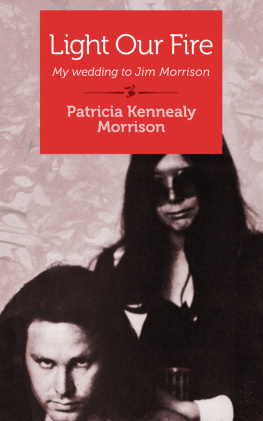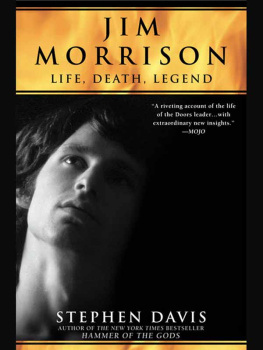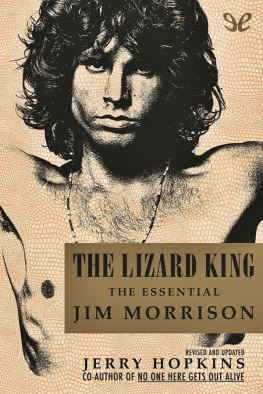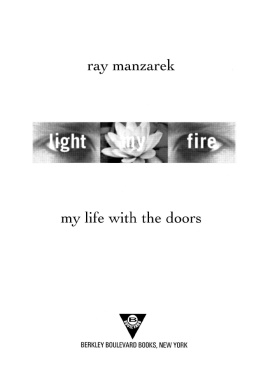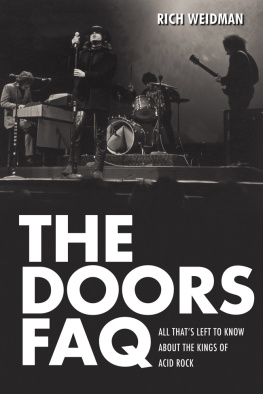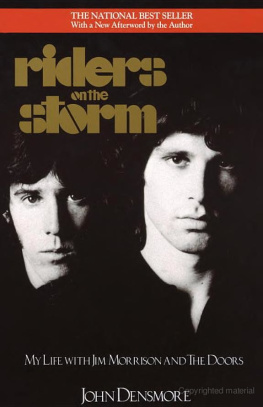Bob Seymore - The end: the death of Jim Morrison
Here you can read online Bob Seymore - The end: the death of Jim Morrison full text of the book (entire story) in english for free. Download pdf and epub, get meaning, cover and reviews about this ebook. year: 2012, publisher: Music Sales Limited, genre: Detective and thriller. Description of the work, (preface) as well as reviews are available. Best literature library LitArk.com created for fans of good reading and offers a wide selection of genres:
Romance novel
Science fiction
Adventure
Detective
Science
History
Home and family
Prose
Art
Politics
Computer
Non-fiction
Religion
Business
Children
Humor
Choose a favorite category and find really read worthwhile books. Enjoy immersion in the world of imagination, feel the emotions of the characters or learn something new for yourself, make an fascinating discovery.
- Book:The end: the death of Jim Morrison
- Author:
- Publisher:Music Sales Limited
- Genre:
- Year:2012
- Rating:3 / 5
- Favourites:Add to favourites
- Your mark:
- 60
- 1
- 2
- 3
- 4
- 5
The end: the death of Jim Morrison: summary, description and annotation
We offer to read an annotation, description, summary or preface (depends on what the author of the book "The end: the death of Jim Morrison" wrote himself). If you haven't found the necessary information about the book — write in the comments, we will try to find it.
A budget-priced edition of the top-selling investigation into the controversial death of Doors singer, Jim Morrison.
The end: the death of Jim Morrison — read online for free the complete book (whole text) full work
Below is the text of the book, divided by pages. System saving the place of the last page read, allows you to conveniently read the book "The end: the death of Jim Morrison" online for free, without having to search again every time where you left off. Put a bookmark, and you can go to the page where you finished reading at any time.
Font size:
Interval:
Bookmark:

Copyright 1990 Bob Seymore
This edition 2012 Omnibus Press
(A Division of Music Sales Limited, 14-15 Berners Street, London W1T 3LJ)
Edited by Chris Charlesworth
Cover and book designed by Lisa Pettibone, Four Corners Design
Picture research by Paul Giblin & Bob Seymore
Cover photo by Barry Plummer
EISBN: 978-0-85712-759-4
The Author hereby asserts his / her right to be identified as the author of this work in accordance with Sections 77 to 78 of the Copyright, Designs and Patents Act 1988.
All rights reserved. No part of this book may be reproduced in any form or by any electronic or mechanical means, including information storage and retrieval systems, without permission in writing from the publisher, except by a reviewer who may quote brief passages.
Every effort has been made to trace the copyright holders of the photographs in this book, but one or two were unreachable. We would be grateful if the photographers concerned would contact us.
A catalogue record of this book is available from the British Library.
For all your musical needs including instruments, sheet music and accessories, visit www.musicroom.com
For on-demand sheet music straight to your home printer, visit www.sheetmusicdirect.com

DEDICATION:
for Hopo
THE AUTHOR is grateful to the following for their contributions to the research and production of this book: Marta de Lapresle, who started the ball rolling; Nick Gough, who was always around; Professor Austin Gresham, for free professional advice; Mr Thomas and his son Patrick, neighbours of Jim and Pam; Monsieur A. Chastagnol, Jims neighbour in Paris and the last man outside of officials to have seen Jims body; Richard Chainey, for the feedback; Christopher English at the US Embassy in Paris; Nadine Sim, for her dedication and patience, and her friend Marie-Laure Brilland for collecting the necessary files and paperwork; Capt. Mercier and Lt. Col. Galeraud, in Paris; Dr. Rob Stepney and Dr. Neville Silverston; Barry Miles and Chris Charlesworth for editorial advice; Danny Sugerman in Los Angeles; and finally my wife Patsy who coped in the most desperate of circumstances.
Bob Seymore, January 1991.

CHAPTER ONE
J IM LEFT FOR Paris right in the middle of mixing LA Woman. There was really no reason for Jim to be there for the mix. He said, You guys finish up Im going to Paris. We said, OK man, talk to you later. I havent heard from him since. Ray Manzarek, 1981.
I saw Pam a few months afterwards, and when I looked into her eyes, I felt pretty much that Jim was dead on the other hand hes just about the only person Ive met who was wild enough to pull a fast one like that. John Densmore, 1972.
If Pamela was any indication, then Jim was dead. She wasnt faking it. This was a woman who was totally broken up. Jim was her total life and she was devastated, so I assume Jim was dead from her reaction and the fact that the coffin was put into the ground, and that no-one else has ever said otherwise. But who knows? Ray Manzarek, 1980.
E VER SINCE I first heard their music, Ive always loved The Doors. There was an element of menace about them that forced you to sit up and take notice; passivity was out, confrontation, participation, action was in. They were an acquired taste, never really easy on the ears, but once youd acquired the taste The Doors and their music were wonderful.
The Doors, and singer Jim Morrison in particular, never did anything by halves. They seemed deeply committed to their music and the lifestyle that went with it, and the depth of this commitment was never likely to sit well with the guardians of law and order, the moral majority. Jim in particular found himself at odds with all and sundry during his ascendancy to rock hero status between 1967 and 1970.
From all published accounts it seems that Jim was far from blameless for the wild reputation he earned. Various biographies paint a portrait of an arrogant, selfish and generally rather unpleasant fellow. Even as a youngster there was nothing he liked better than to needle anyone and everyone who came into his orbit, and as he grew older and more threatening this included anyone in authority, absolute total strangers and even the other Doors and their entourage. It seems to be no secret that neither drummer John Densmore nor guitarist Robbie Krieger were on the best of terms with Jim for much of The Doors career, while Ray Manzarek, who discovered Jim, was only slightly more tolerant, probably because of their mutual interest and backgrounds in avant garde film making. John and Robbie were professional musicians, anxious to offer their best at every show and reap the substantial rewards that rock stars could expect at the end of the sixties; Jim not only compromised their chances of doing this but couldnt give a damn most of the time either.
Morrison had no desire for material comforts, nor was he particularly interested in a career as a musician. He often slept wherever he happened to drop. Apart from a few books and the ubiquitous leather pants he had few possessions, nor did he seek any form of traditional stability or security. More often than not he was drunk, stoned on grass, or both, and he seemed to take pleasure in behaving badly in public in order to embarrass the company he was with.
This last trait he sometimes tried to justify as a form of social experiment; Jim Morrison was not typical as far as rock stars go. For a start, he was exceptionally well educated in the arts, and possessed of a natural curiosity that never took things for granted. He was an avid reader of serious literature, philosophy and poetry since his early teens, an underground film buff (and student) and a man drawn towards deep philosophical arguments and anarchic experiments about human behaviour and the limits of mans endurance. Estranged from his family especially his career naval officer father and given to wild attention-grabbing gestures, he lurched dangerously into Southern California like a loose cannon aboard a storm-tossed warship.
Then came The Doors. He met Ray Manzarek, a classically trained pianist and fellow film student, on the beach at Venice in the summer of 1965, recited some words from a poem hed written called Moonlight Drive and responded immediately to Rays suggestion that they form a group and make a million dollars. John Densmore and Robbie Krieger were quickly recruited they had met Ray at a meditation class and after some chaotic rehearsals, The Doors, named after Aldous Huxleys quote from William Blake, The Doors Of Perception, began playing week nights at an unfashionable club called the London Fog on Sunset Strip.
After a few false starts Elektra signed them in late 1966 and their future was assured when their stunning dbut album was released the following year. Twelve months on they were big stars with Jim, the leader, far and away the brightest of their galaxy.
But he was a mass of contradictions, probably schizophrenic, and the heavier the mantle of celebrity the worse his behaviour became and the more he sought to escape. The extrovert and anti-social behaviour on and off stage was the action of a man who considered himself to be a true artist who thought that people were not taking him seriously. The Doors attempted to put across something deeper than just rock and roll music but somehow they found themselves categorised amid the commercial side of the music business and not played on underground (FM) radio as much as they would have liked. Many younger fans who had not seen the group live thought of The Doors as a band who made Top 20 singles like Light My Fire and Hello I Love You both number hits in the USA and not as an album act like The Grateful Dead who never even released singles. The Doors also came from Los Angeles at a time when all the underground music, the music of The Dead and Jefferson Airplane for example, was assumed to come from San Francisco, though Frank Zappas Mothers of Invention were from LA and the Velvet Underground was from New York and this didnt seem to stop them getting plenty of airplay on underground and college radio stations.
Font size:
Interval:
Bookmark:
Similar books «The end: the death of Jim Morrison»
Look at similar books to The end: the death of Jim Morrison. We have selected literature similar in name and meaning in the hope of providing readers with more options to find new, interesting, not yet read works.
Discussion, reviews of the book The end: the death of Jim Morrison and just readers' own opinions. Leave your comments, write what you think about the work, its meaning or the main characters. Specify what exactly you liked and what you didn't like, and why you think so.

